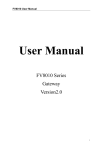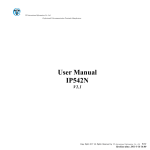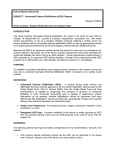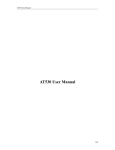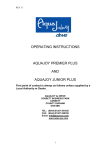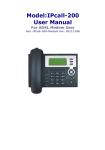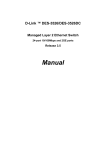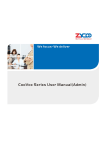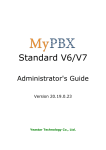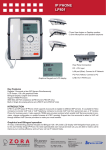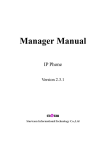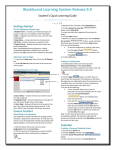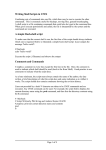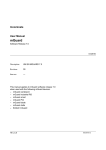Download JR168-900 User`s Manual
Transcript
User Manual JR168-900 IP Phone Version 1.2 1 Contents 1. PRODUCT OVERVIEW.......................................................................................................... 4 1.1. MAIN FUNCTION .................................................................................................................... 4 1.2 HARDWARE SPECIFICATIONS .................................................................................................... 5 2. INSTALLATION .......................................................................................................................... 6 2.1.PRODUCT OVERVIEW AND PART ................................................................................................ 6 2.2 .PACKAGE LIST ......................................................................................................................... 6 AWARNING ..................................................................................................................................... 6 2.3 INSTALLATION ........................................................................................................................... 6 2.4 LCD IRON DEFINITONS ............................................................................................................. 7 3. PRODUCT FEATURES ............................................................................................................... 8 3.1 SOFTWARE FEATURES .............................................................................................................. 8 3.2 HARDWARE FEATURES .............................................................................................................. 9 4 BASIC OPERATIONS .................................................................................................................. 9 4.1 GET FAMILIAR WITH KEYPAD .................................................................................................... 9 4.2 DIALING AND MAKING CALLS .................................................................................................. 11 4.2.1 Dialing General PSTN Phone or Extension. .......................................................... 11 4.2.2 IP to IP Calling............................................................................................................. 11 4.2.3 Answering Calls.......................................................................................................... 12 4.2.4 Call Hold....................................................................................................................... 13 4.2.5 Call Transfer ................................................................................................................ 13 4.2.6 Three-Way Calling ...................................................................................................... 13 5 CONFIGURATION GUIDE........................................................................................................ 14 5.1 CONFIG IP PHONE THROUGH KEYPAD .................................................................................... 14 5.1.1 Menu Structure: .......................................................................................................... 14 5.1.2 Keypad Corresponding Symbol Table.................................................................... 14 5.2 CONFIGURATION PROCEDURE FOR BASIC OPERATIONS: ........................................................ 15 5.2.1 Network Configuration by Keypad .......................................................................... 15 5.2.2 Common Shortcut Keys ............................................................................................ 16 5.2.3 Save and clear configuration ................................................................................... 17 5.2.4 Reboot IP Phone ......................................................................................................... 17 6. WEB CONFIGURATION .......................................................................................................... 17 6.1 PHYSICAL CONNECTION ......................................................................................................... 17 6.2 PREPARATION FOR W EB CONFIGURATION .............................................................................. 17 6.3 USER VERIFICATION ............................................................................................................... 20 6.4 CURRENT STATE .................................................................................................................... 21 6.5 NETWORK CONFIGURATION .................................................................................................... 22 6.5.1 WAN Configuration .............................................................................................. 23 6.5.2 LAN Configuration ............................................................................................... 24 2 6.6 VOIP CONFIGURATION........................................................................................................... 25 6.6.1 SIP1 Configuration ..................................................................................................... 25 6.7 ADVANCE ............................................................................................................................... 28 6.7.1 DHCP Server Configuration ...................................................................................... 28 6.7.2 NAT Configuration ...................................................................................................... 29 6.7.3 NAT Service Configuration ....................................................................................... 30 6.7.4 Firewall ......................................................................................................................... 31 6.7.5 QOS 802.1p Configuration ........................................................................................ 32 6.7.6 Advance SIP Configuration ...................................................................................... 32 6.7.7 Digital Map Configuration ......................................................................................... 34 6.7.8 Call Service Configuration ........................................................................................ 35 6.7.9 MMI Filter ..................................................................................................................... 39 6.7.10 DSP Configuration ................................................................................................... 39 6.8 DIAL PEER.............................................................................................................................. 40 6.9 CONFIG MANAGE (SAVE AND CLEAR CONFIGURATION)........................................................... 44 6.9.1 Save Config ................................................................................................................. 44 6.9.2 Clear Config................................................................................................................. 44 6.10 FIRMWARE UPGRADE ........................................................................................................... 44 6.10.1 Web Update ............................................................................................................... 44 6.10.2 FTP or TFTP Update ................................................................................................. 45 6.11 SYSTEM MANAGE ................................................................................................................. 46 6.11.1 Account Manage (maximum 5 accounts ) ............................................................ 46 6.11.2 Phone Book Configuration ..................................................................................... 47 6.11.3Syslog Configuration ................................................................................................ 48 6.11.4 Time Set ..................................................................................................................... 49 6.11.5 System Reboot.......................................................................................................... 49 7.TELNET CONFIGURATION..................................................................................................... 50 7.1 CONFIG PROCEDURE ............................................................................................................. 50 7.2 GLOBAL COMMAND ................................................................................................................ 51 7.3 NET CONFIGURATION ............................................................................................................. 52 7.3.1 LAN interface Settings .............................................................................................. 52 7.3.2 WAN Interface Settings ............................................................................................. 52 7.3.3 Net Service .................................................................................................................. 52 7.3.4 SIP Settings ................................................................................................................. 53 7.3.5 User Management .................................................................................................... 53 7.3.6 Debug (Level 0~7) .................................................................................................... 54 7.3.7. Show System Running Info. .................................................................................... 54 7.3.8. Logout ......................................................................................................................... 55 7.3.9. Tracert....................................................................................................................... 55 7.3.10. Update ....................................................................................................................... 55 8. POST MODE(SAFE MODE) ..................................................................................................... 56 8.1 ACCESS POST MODE PROCESS ............................................................................................. 56 10. Default pre-configuration of the system…………………………………………………….56 3 1. Product overview 1.1. Main function 1.1.1. Networking . Integration of the two ports router, you can configure the appropriate use of their small local area network; . support three ways configured WAN IP, they are: static (LAN static allocation), DHCP (dynamic access to LAN) and PPPoE (ADSL access dynamic way); . WAN can support the analytical domain DNS SRV; . connected to the LAN to provide small LAN DHCP services; .connected to the LAN of the small LAN to provide NAT services; .connected to the LAN to provide small LAN firewall control; . connected to the LAN mouth of the small LAN to provide optional communications priority; . offer a bridge model,as it can be used as a small switch; . support the second layer QoS (802.1p); 1.1.2.Basic calling feature .Support SIP2.0 .support of the main backup server automatically switch .use RTP and RTCP for voice communication; .use advanced digital signal processing (DSP) technology to ensure high-definition voice quality; .use advanced buffer control technology to prevent large packet delay and loss; . support a variety of popular voice codecs, they are G711 (Alaw64K/Ulaw64K), G.723 (r53/r63), G.729; .support DTMF band and out-of-band transmission; .support a number of countries and regions in the ring; 1.1.3. Advanced calling features .support STUN and NAT penetration; .use private agents to provide convenience of communication with managers. .support voice, the voice prompts, caller ID, call waiting, call forwarding, 4 three-call, a variety of ways prior to the call, free bother, ban-dial, automatic response, the pick automatically dial, speed -dial; .set blacklist number and restrictions number .support point-to-point direct call; .to set up phone; .support phone to add, delete and replace; .set a fixed call .use a number to record contact name, number and address; .support mute suppression, call detection; .support background noise simulation; .support echo suppression and automatic gain; .support DIGEST and MD5/MD5-sess package; 1.1.4. Management .set up multiple administrator access and user name and password; .support configuration by keyboard,Http and Telenet,automated centralized configuration file via Http and Telenet. .support upload upgrade file and educe configuration file via Http and FIP/TFIP .support reverse Telnet through the NAT / firewall for long-distance management; 1.2 Hardware Specifications Item JR168-900 Network Interface 2 * RJ45 10/100 Base-T Phone keyboard 28 buttons, a knob, a LCD appearance Power Adapter Input: 100-240VAC 50~60Hz Output: +5VDC, 1200mA Dimension (W×H×D) 11.6× 8× 3 inch (29.5×20.5×7.5cm) Operating Temperature 0~40℃(32°~104℉) Relative Humidity 10~65% (Non-condensing) Weight (packaging 2.07 lb. (0.94kg) included) 5 2. Installation 2.1.product overview and part JR168-900 series IP phones are designed to look and feel like standard telephones. The following photo illustrates the appearance of an JR168-900 IP phone and the use of its key buttons. 2.2 .Package List The JR168-900 phone package contains: . One JR168-900 phone . One universal power adapter . One Straight Ethernet cable Awarning The phone should only be operated with the universal power adapter provided with the package. Damages to the phone caused by using other unsupported power adapters would not be covered by the manufacturer‘s warranty. 2.3 Installation 1) Insert handset cord into the handset jack and left jack of IP Phone 2) Insert the power adapter‘s plug into the phone front Power jack (DC 5V) and the 2-prong plug end of which into grounded power outlet 3) Start up the IP phone by turning the front switch stated ‗ON‘ & ‗OFF‘ to 6 ‗ON‘ 4) Remove the LAN cable for Internet connection from your PC and connect it to WAN port, then follow below installation checking way 5) If need to set up small LAN network, find the LAN cable in the box and connect between LAN port and your PC (PC is not required to set up for making a call) 2.4 LCD Iron definitons JR168-900 IP Phone has a 80mmx40mm LCD that can display three lines of below characters each. Here is the display when all segments illuminate: The LCD is equipped with a backlight. When the phone is in the normal idle state, the backlight is off. Whenever an event occurs, the backlight turns on automatically and brings the user‘s attention. The definitions for each character displayed on LCD described as below table. Icon LCD Icon Definitions Network Status Icon: FLASH in the case of Ethernet link failure or the phone is not registered properly. Network Status Icon: ON when Phone work on DHCP mode and FLASH when DHCP client is not registered successfully. OFF when Phone is work on another mode. Network Status Icon: ON when Phone work on Static mode and FLASH when IP address is disable. OFF when Phone is work on another mode. Network Status Icon: ON when Phone work on PPPoE mode and FLASH when PPPoE is not registered successfully. OFF when Phone is work on another mode. Message Status Icon: ON and Flash if Phone has new message include text message or voice record Missed call display ON and Flash if Phone has missed call and not be read. 7 SIP1 (Public SIP server) register Status: Flash when enable register and can not register successfully, ON when enable register and register successfully, OFF when disable register SIP2 (Private SIP server) register Status Icon: Flash when enable register and can not register successfully, ON when enable register and register successfully, OFF when disable register Handset Status Icon: ON when off-hook OFF when on-hook Hand-free Status Icon: ON when phone work on hand-free mode OFF when IDLE or work on handset mode Weekday Status Icon: Show the correct weekday according to the phone current date … Numerical Numbers and Characters: 0 - 9 * # @ A, B, C, D, E, F, G, H, I, J, K, L, M, N, O, P, Q, R, S, T, U, V, W, X, Y, Z 3. Product features 3.1 software features . Support two models: Bridge and Router(NAT&NAPT) Network Protocols: TCP/UDP/IP、ICMP、HTTP、DHCP Client(WAN Interface)、DHCP Server(LAN Interface)、DNS Client、DNS Relay、 SNTP、PPPoE、FTP、TFTP VoIP Protocols: Support IAX2&SIP (RFC3261, RFC3262, RFC3264, RFC3265) synchronously Voice Codecs: G.711(A-law/U-law)、G.723.1(high/low)、G.729 NAT transversal: Support STUN client, AVS and Citron etc . Can modify SIP register port、HTTP server port、Telnet server port and RTP port Support two SIP server synchronously:Can register two different SIP server, and can make a call by either proxy Support standard voice features such as numeric Caller ID Display, Call Waiting, Hold, Transfer, Do-Not-disturb, Forward, in-band and out-of-band DTMF, Hotline (off hook autodial), auto answer,ban outgoing Full duplex hands-free speakerphone, redial, call log, volume control, voice record with indicator Support standard encryption and authentication (DIGEST using MD5, 8 MD5-sess) Support Silence Suppression, VAD (Voice Activity Detection), CNG (Comfort Noise Generation), Line Echo Cancellation (G.168), and AGC (Automatic Gain Control) Provide easy configuration thru manual operation (phone keypad、Web interface and Telenet) or automated centralized configuration file via TFTP or HTTP. Support firmware upgrade via TFTP/FTP and HTTP Support syslog, can send event of phone to syslog server. 3.2 hardware features Item JR168-900 Power Adapter Input: 100-240VAC 50~60Hz Output: +5VDC, 1200mA CPU Port Infineon PSB21553 150MHz WAN 10/100Base T RJ-45 for LAN LAN 10/100Base T RJ-45 for PC Power Consumption Idle:1.4W / Active:1.8W LCD size 3 inch (74×28mm) Operating Temperature 0~40℃(32°~104℉) Storage Temperature -10°~60℃(14°~140℉) Relative Humidity 10~65% (Non-condensing) Dimension (W×H×D) 11.6× 8× 3 inch (29.5×20.5×7.5cm) Weight (packaging 2.07 lb. (0.94kg) included) Certification CE / FCC Part 15 Class B 4 Basic Operations 4.1 Get Familiar with Keypad Key Button 0 -9 Mode In the dial-up mode Definitions Decimal digit number 0-9, star and pound keys are usually used to make phone 9 calls In the keypad configure mode Rapid first button press display the digit number 0-9,rapid second button press display the English character or others In the dial-up mode As one part of phone number when call out In the call hold mode Ready to call a third party‘s number to make three-way (or conference) calling In the keypad configure mode Equal to the dots notation when input IP address # In the dial-up mode As one part of phone number when ―#‖ is the first dialed number. otherwise as the ending symbol to end up dialing SYSINFO In the IDLE mode Continuous thrice press display assigned IP address of WAN Port, gateway‘s IP address and the phone number registered on public server ENTER In the keypad configure mode Confirm configuration or enter submenu mode Exit In the keypad configure mode Cancel configuration or exit submenu mode MENU In the IDLE mode Enter menu mode and display the tree menu system HOLD In the keypad configure ode Temporarily hold the active call Transfer In the keypad configure mode Transfer the active call to another party or Enter three-way (or conference) calling. REDIAL/SEND In the dial-up mode Redial the number last dialed, or force a call to go out immediately before timeout SPEAKER In the IDLE mode Enter hands-free mode UP In the keypad configure mode Go back to previous menu item or increase handset/speakerphone volume DOWN In the keypad configure mode Go down to lower menu items or reduce handset/speakerphone volume DEL In the dial-up mode Delete a key entry, call log, voice mail and etc. In the keypad configure mode Modify the current configuration parameter or delete input info In the IDLE mode Mute an active call; * MUTE 10 OUT In the keypad configure mode Browse the outgoing call records (maximum saving 100 records) IN In the keypad configure mode Browse the incoming call records(maximum saving 100 records) REC In the IDLE mode Enter voice mail submenu (maximum saving 5 records) PBOOK In the IDLE mode Access to phone book.(maximum saving 100 records) Note: 1 Outgoing , Incoming ,Missed call support maximum 100 records, but power off will lose the record. 2 Support 5 records: one for local message ,one for welcome message ,three for incoming call leaving message 4.2 Dialing and Making Calls 4.2.1 Dialing General PSTN Phone or Extension. There are three dialing modes: 1. Pick up handset or press SPEAKER button, and then enter the phone numbers, IP phone will send out the numbers with the DTMF tones. 2. In the off hook mode or Hands-free mode, Press the REDIAL/SEND button directly to redial the number last called. Once pressed, the last dialed number will be displayed on the LCD with DTMF tones and an outgoing call is sent. 3. Make use of Speed dialing mode: enter PBOOK→SPEED DIAL→INPUT INDEX submenu to input the index which correspond to the phone number you want to dial, then the phone could automatically dial the number. Process: PBOOKENTER—INPUT INDEX (1,2,3…) + # 4.2.2 IP to IP Calling Making IP to IP calling is nearly same as dialing general PSTN Phone, there are three ways to set IP phone number and domain (more details please refer to 5.2.4) 1. ―Peer to Peer‖ calling mode: direct make calls and no need to set phone number thru proxy server (user could refer to Dial peer setting on web configuration charter).The phone should be operated under following condition (satisfy one option) Requirement 1 both two phones are assigned the public IP 11 address individually Requirement 2 both two phones using private IP address should be on the same LAN. 2. Dialing the IP number configured by public agency, both two phones should be already registered on the public server. 3. Dialing the IP number configured by private agency, both two phones should be already registered on the private server. Examples: To dial a number on the proxy, such as 1001, simply pick up handset or press speakerphone, dial 1001 and then press the REDIAL/SEND button. To dial a PSTN number such as 62281486, you might need to enter in some prefix number followed by the phone number. Please check with your VoIP service provider to get the information. If your phone is assigned with a PSTN-like number such as 62281493, most likely you just follow the rule to dial 62281486 as if you were calling from a regular analog phone, followed by pressing the REDIAL/SEND button. Example 1 f A dial number 187 , A can talk with B . A If B dial number 155 , B can talk with 4.2.3 Answering Calls There are three ways to receive incoming calls: Pick up handset to receive incoming calls Press the SPEAKER button to receive incoming calls Start-up the voice message function to record the incoming calls, afterwards listen to voice messages thru phone audio play . 12 Operations: Enter REC→RECEIVED→NEW→UP OR DOWN to the LIST NO submenu (maximum is 3 message) 。 Precondition : must enable in Advance /Call service Note: User can switch from a hands-free call to handset by picking up the handset. To switch from a handset call to a hands-free call, press hands-free button, and then hang up the handset. 4.2.4 Call Hold Pressing the HOLD button during current conversation enables you put an active calling on hold temporarily while a second call is answered or made, press this button again will go back to the previous call. Precondition : must enable in Advance /Call service 4.2.5 Call Transfer Press the TRANSFER button enables users could transfer an incoming call to the third party‘s number. When user A and user B both sides are on conversation, Users A press <TRANSFER > button ,and then dial the thid party user C . User A will hand up . User C ring , User B is on Hold state. User C pick up ,and talk with user B . Precondition : must enable in Advance /Call service Process: Transfer button + the third party number Example:A is talking with B , A press <Transfer> button and dial C number. A line break, then B will talk with C. 4.2.6 Three-Way Calling IP phone support three-way (or conference) Calling. That is users could talk to more than one person (up to two) at the same time. Process: press HOLD button →Dial third party‘s number->put through→ press HOLD button again →Press * button Once the three-way initiator concludes the three-way calling, the other two sides can not continue the conversation call and hand up automatically. 13 Example: A are talking with B. A press HOLD button for holding B line , and dial the third party`s number , so A will talk with C . A press HOLD button again for holding C line , A dial * , make three-way (or conference) calling successfully. Pro-condition: enable the three functions as below picture. Note: The function 4.4 & 4.5 & 4.6 could be started or closed thru system setting, so when you need to use above three functions please make sure of opening these functions. 5 Configuration Guide 5.1 Config IP Phone through Keypad 5.1.1 Menu Structure: 5.1.2 Keypad Corresponding Symbol Table 14 5.2 Configuration Procedure for Basic Operations: Setup WAN Port IP Config VOIP Phone protocol (e.g. config SIP protocol) 5.2.1 Network Configuration by Keypad Press MENU button→Input password ―123‖→Press ENTER button to confirm. Configure WAN Port IP address: NETWORK→WAN→STATIC NET→IP If using DHCP or PPPoE to get IP address dynamically, find user name on NETWORKWANPPPoEUSER NAME If using DHCP or PPPoE to get IP address dynamically, find password on NETWORKWANPPPoEPASSWORD Configure WAN Netmask: NetworkWAN STATIC NET NETMASK Configure WAN Gateway: NetworkWAN STATIC NET GATEWAY Configure WAN DNS address: NetworkWAN STATIC NETDNS Finished all above network configuration, Users can connect IP phone to internet successfully. JR168-900 IP Phone supports to modify IP address using keypad; Users could refer to the following flow chart to get a clear picture. Configuration Example: Set IP address of Phone WAN port to 192.168.1.70 and LAN port to 192.168.20.1 15 MENU IP 192.168.1.70 1.INPUT “123”+ ENTER Key 15.ENTER Network Input Value: 192.168.1.70 2. ENTER Key 14.Input 192.168.1.70 LAN 3. ENTER Key 13.DEL Key IP 4. ENTER Key IP 192.168.10.1 Input Value: IP 192.168.1.179 12.ENTER IP 5.DEL Key 11.ENTER Input Value: 6.Input 192.168.20.1 Input Value: 192.168.20.1 IP 192.168.20.1 7.ENTER Key Static net 10.ENTER LAN 8.Press EXIT twice WAN 9.UP/DOWN Note: IP Phone must config the correct WAN port IP address and Gateway IP address before connecting to internet. Due to JR168-900 Phone Default mode is router, (bridge mode is disable) so the WAN port IP could not be set to the same segment with LAN Port IP address when you modify WAN Port IP. Otherwise the,JR168-900 can not get into internet. But, if you had set wan port and LAN port to same ip segment , you need to set JR168-900 to factory default. Process: power off ,and press # ,then power on ,input *#168 , and restart the fv6020 Default factory setting of WAN configuration is DHCP Client model Default LAN Port IP=192.168.10.1 (Users could get them by pressing SYSINFO Key) 5.2.2 Common Shortcut Keys 16 Keep pressing 1 key for three seconds, Wan port IP switch to static. Keep pressing 2 key for three seconds, Wan port IP switch to DHCP. Keep pressing 3 key for three seconds, Wan port IP switch to PPPOE 5.2.3 Save and clear configuration Enter MENU->SYSTEM->SAVE to config; Enter MENU->SYSTEM->SETFAULTto clear configuration; 5.2.4 Reboot IP Phone Enter MENU→SYSTEM→REBOOT submenu to reboot IP Phone Note: if no responding on phone, please cut off power supply to reboot phone. 6. Web Configuration 6.1 Physical Connection 6.2 Preparation for Web Configuration The IP Phone Web Configuration Menu can be accessed by the following URI: http://Phone-IP-Address. The IP address can be set to either WAN IP address or LAN IP address, default factory setting of WAN configuration is DHCP Client model, default LAN IP address is ―192.168.10.1‖. If connect PC with IP Phone LAN port and config to obtain IP address automatically, you could check the default gateway IP namely LAN IP address 17 of IP Phone. The procedure as below a) Access to ―Property of local area connection‖ dialog box b) Select ―Internet Protocol (TCP/IP)‖,click ―Property‖ button c) Setting refers to below dialog box, and then click ―OK‖ button, PC will obtain IP address automatically. or set your pc static ip 192.168.10.2 18 d) Input ―cmd‖ command on the RUN submenu under PC START, key in ―ipconfig/all on the command lines dialog box to find the default gateway IP address, which is LAN IP address of IP Phone. 19 6.3 User verification Users are requested to make verification when config or browse the IP phone thru web pages, users can direct login the config menu by inputting username and password as below: Default username and password is: Administrator: Username=admin password= admin high level user interface User: Username=guest password=guest low level user interface 20 6.4 Current State On this page user can gather information of each commonly-used parameter of the phone, it is shown as the following figure: Network section: Display the current WAN, LAN configurations of the phone VoIP section: Display the current default signaling protocol in use,and server parameter in use of each protocol Phone Number section: Display the phone number against each protocol The version number and date of issue have been shown at the end of this page 21 6.5 Network Configuration Network configuration includes WAN Config and LAN Config. 22 6.5.1 WAN Configuration This web page displays the WAN parameter configuration. Display <valid MAC >, that means the phone had been certificated. Display <invalid MAC>, that means the phone need a Mac Authenticating Code .(get it from Fanvil or your provider ) Display <invalid MAC, that means the phone can not work normally. WAN port support Static /DHCP/PPPoE. Users can set the right model base on actual requirements. Connect network to internet thru Static mode WAN default network config is DHCP model; So Users need to set below parameters IP Address Netmask Gateway WAN IP address Network mask Default gateway IP address DNS Domain Option configuration 23 Primary DNS Alter DNS IP address for primary Domain Name Server Option configuration Click ―Apply‖ button after finished above setting, IP Phone will save the setting automatically with immediate effect. If users visit IP Phone thru WAN, it need to input ―ipconfig‖ command to get the new IP address and copy it to web browser bar to visit IP Phone. Connect network to internet thru DHCP mode Select ―DHCP‖ on below single option, IP Phone will auto-config the WAN parameter with immediate effect. Connect network to internet thru PPPoE mode Select ―PPPOE‖ on below single option, Set below parameter of PPPOE mode Server User Password If ISP no special requirements, remains default setting Provided by ADSL ISP Provided by ADSL ISP Click ―Apply‖ button after finished above setting, IP Phone will auto-config the WAN parameter with immediate effect. The setting of WAN is still effective and enables IP Phone to connect to internet. 6.5.2 LAN Configuration This web page displays the LAN parameter configuration. Please note once the bridging mode is selected, the LAN configuration will be no longer effective. 24 Configuration Example Config LAN: generally config one private IP address IP Netmask LAN IP address Network Mask Start LAN DHCP Service and NAT or not: default setting is start Start Bridge Mode or not(transparent mode): Once start Bridge Mode, some parts of LAN config will be disabled, and the phone will no longer set IP address for LAN physical port,LAN and WAN will join in the same network. 6.6 VOIP Configuration This section is to config signaling protocol for the SIP and IAX2 Server and Client. 6.6.1 SIP1 Configuration User can configure specific parameter of SIP1 signaling protocol on this page; Definition of each parameter described as below 25 Definition of each parameter described as below: SIP[Unregistered] SIP register state;if register successfully, show Configuration ―Registered‖ in the square bracket , otherwise show Unregistered RegisterServer address Set SIP register server IP address Set proxy server IP address ( usually SIP will Proxy Server addr provide the same configuration of proxy server and register server, if different(such as different IP addresses), then each server's configuration should be modified separately) Register Server Port Proxy Server Port Register Username Proxy Username Register Password Proxy Password Domain Realm Local SIP Port Phone Number Register Expire Time Detect Interval Time Set SIP register server signal port Set SIP proxy server signal port Set SIP register server account username(Usually it is the same with the config port number) Set the SIP proxy server account username Set password of SIP register server account Set password of SIP register account Enter the sip domain if needed, otherwise FV6020 will use the proxy server address as sip domain. (Usually it is same with registered server and proxy server IP address). Set local signal port,the default is 5060 Set assigned phone number Set expire time of SIP server register, default is 60 seconds Set detection interval time of server, default is 60 26 RFC Protocol Edition DTMF Mode seconds Enable the phone to use protocol edition. When the phone need to communicate with phones using SIP1.0 such as CISCO5300 and so on, need to change to RFC2543. the default is to RFC3261; Set DTMF sending mode, support RFC2833, DTMF_RELAY (in-band audio) and SIP info User Agent Set the user agent if have, default is Voip Phone 1.0 . I If Server type is ―net2phone: ,please fill in wan port mac address. Enable Register Configure enable/disable register Auto Detct Server configuration automatic detection server, the choice of words after JR168-900 automatic detection and the opportunity to switch servers, to detect when the main server can not use it when the chance to switch to the backup server, and detecting the main server at the same time, when the main server available When, JR168-900 so the opportunity to automatically switch back Enable Pub Outbound use a same agents to configu, if not configured Proxy STUN function or used in local area network, this is the best choice SIP (Default Protocol) configuration use the SIP protocol to configu phone. it‘s the default agreement After finished the aforesaid network and VoIP configurations on the phone and network communication has been implemented,the user can make VoIP calls by the calling register and proxy server. Note: Some ISP internet may inhibit the phone to register and cancel the register in process, so user had better cancel apply or register soon and then submit registration repeatedly. Server may stop response of dialogue machine, then the phone receives no register/cancel login request and registration state will show incorrectness! Configuration Example Firstly users should get the account info from VOIP Operator (Including Server IP address, port, username, password etc.) and follow below procedure. Config registered server and proxy server IP address and signaling port. 27 (Support DNS for registered server and proxy server) Config the username and password for registered server and proxy server. Config the phone number (Usually phone number is same with SIP account) Remark: due to the above register username is ―client‖, so the phone number is different from SIP account) Config the domain realm (Usually it is same with registered server and proxy server IP address, Let it be blank) Select the below option and registered. Usually the option need to be selected, when you want to use SIP1. 6.7 Advance 6.7.1 DHCP Server Configuration When JR168-900 work as a router, this config is for LAN port network device DNS Relay: DNS relay acts as a forwarder between the DNS Clients and the DNS Servers, DNS relay is designed for home/office networks where the users might want to dial into more than one Internet Service Provide (ISP) DHCP server manage page. User may trace and modify DHCP server information in this page. DNS Relay: enable DNS relay function. User may use below setting to add a new lease table. 28 Lease Table Name: Lease table name. Lease Time: DHCP server lease time. Start IP: Start IP of lease table. End IP: End IP of lease table. Network device connecting to the JR168-900 LAN port can dynamic obtain the IP in the range between start IP and end IP. Netmask: Netmask of lease table. Gateway: Default gateway of lease table DNS: Default DNS server of lease table. Notice: This setting won’t take effect unless you save the config and reboot the device 6.7.2 NAT Configuration This page is for NAT configuration, such port forward, DMZ . Network Address Translation (NAT) provides a mechanism for a privately addressed network to access registered networks, such as the Internet, without requiring a registered subnet address. This eliminates the need for host renumbering and allows the same IP address range to be used in multiple intranets. With NAT, the inside network continues to use its existing private or obsolete addresses. These addresses are converted into legal addresses before packets are forwarded onto the outside network. Advance NAT setting: Maximum 10 items for TCP and UDP port mapping. IP Sec ALG: Enable/Disable IP Sec ALG; FTP ALG: Enable/Disable FTP ALG; PPTP ALG: Enable/Disable PPTP ALG; Transfer Type: Transfer type using port mapping. Inside IP: LAN device IP for port mapping. Inside Port: LAN device port for port mapping. Outside Port: WAN port for port mapping. Click Add to add new port mapping item and Delete to delete current port mapping item. 29 6.7.3 NAT Service Configuration Configure web browse port, the default is 80 port,if you want to enhance system safety,you'd better change it into non-80 standard port; the accessing address is http://xxx.xxx.xxx.xxx:xxxx/ But if the value is 0, that imply it can not be configured by web browser. Configure telnet port,the default is 23 port. You can change the value to others. Example: The IP address is 192.168.1.70. you change the port value to 8023, the accessing address is telnet 192.168.1.70:8023 Enable RTP initial port configuration. It is dynamic allocation; Configure the maximum quantity of RTP port. The default is 200; Leased IPMAC correspondence table of DHC. The table will display all device getting IP address from JR168-900 LAN port by DHCP. The configuration on this page needs to be saved after modified and will go into effect after restarting. If the Telnet, HTTP port will be modified, the port is better to be set as greater than 1024,because the 1024 port system will save ports. ※Set the HTTP port as 0,then the http service will be disabled. 30 6.7.4 Firewall Firewall Setting Page. User may set up firewall to prevent unauthorized Internet users from accessing private networks connected to the Internet (input rule), or prevent unauthorized private network devices to access the internet. Access list support two type limits: input_access limit or output_access limit. Each type support 10 items maximum. JR168-900 firewall filter is base on WAN port. So the source address or input destination address should be WAN port IP address. Configuration: in_access enable: enable in _access rule out_access enableA: enable out _access rule Input/Output: specify current adding rule is input rule or output rule. Deny/Permit: specify current adding rule is deny rule or permit rule. Protocol Type: protocol using in this rule: TCP/IP/ICMP/UDP. Port Range: port range if this rule Src Addr: source address. can be single IP address or network address. Dest Addr: Destination address can be IP address or network address. Src Mask: source address mask. Indicate the source is dedicate IP if set to 255.255.255.255. Otherwise is network ID Des Mask: Destination address mask. Indicate the source is dedicate IP if set to 255.255.255.255. Otherwise is network ID 31 6.7.5 QOS 802.1p Configuration Qos Enable is Qos service QoS Control based on 802.1p for different IP users. The QoS is used to mark the network communication priority in the data link/MAC sub-layer. Ip phone will sorted the packets using the QoS and sends it to the destination. QoS provides service classes for accessing traffics in Internet. DiffServ replace IP type of service . the field change to DS field . It take IP service infomation that is necessary. It is strict three layer technology, it do not involve the low layer tranfer technology Qos Enable:Configure enable/cancel service QoS Table: QoS table including that set Qos table of the network address is the need to provide services Qos address, the address of outside sheet does not provide qos; cancel selected qos table,it means that ardress of outside sheet is the need to provide services. Delete:enter the corresponding index number to delete the list; Add: users can add qos fill in the corresponding list of IP address and netmask 6.7.6 Advance SIP Configuration 32 To show the phone whether has been registered on public server or private server SIP STUN Configuration: STUN can support SIP terminal's penetration to NAT in the inner-net. In this way, as long as there is conventional SIP proxy and a STUN server placed in the public net, it will do; but STUN only supports three NAT modes:FULL CONE, restricted, port restricted. IF you have stun server .please input stun server address here. The STUN server default port is 3478 Configure enable/disable SIP STUN;if you have stun server .please enabe the option. Public backup server configuration public backup server configuration; specific configuration parameters has the same meaning with public server.it should be noted that the username and password should be the same with the public main server Private Server(SIP2) Configuration. Private server configuration.sepcific configuration parameter has the same 33 meaning with public server Configure permit/deny private server register Configuere enable/disable private outbound proxy.if user don‘t have STUN server,you‘d better to select this service 6.7.7 Digital Map Configuration 6.7.7.1 Fixed Digital Map JR168-900 IP Phone dial rule End With ―#‖: Checked : # Fixed Length: When the length of the dialing match, the call will be sent. # for the end of dialing. User dial phone end with Timeout: Specify the timeout of the last dial digit. The call will be sent after timeout 6.7.7.2 User Define Flexible Digital Map Table Digit map is a set of rules to determine when the user has finished dialing. Digital Map is based on some rules to judge when user end their dialing and send the number to the server. With digital map, users don‘t have to press ‗#‘ key or "call"key after dialing. If the number dialed matches some item in the digital map table, or it doesn‘t match with any item, this number will be sent out immediately. It is not like using dial peer . Using digital map won‘t change the number dialed, the number sent is the same as the number dialed. x represents any one number between 0 and 9. Tn represents the last digit timeout. here [ n ] represents the time from 0~9 second, it is necessary. Tn must be the last two digit in the entry. If Tn is not included in the entry, we use T0 as default, it means system will sent the number immediately if the number matches the entry. (Dot) represents any number and no length limit. [ ] number location value range . It can be a number range(such as [1-4]), or number is separated by comma such as [1,3,5],, or use a list such as [234] 34 Example: [1-8]xxx 9xxxxxxx 911 99T4 9911x.T4 any 4 digits number between 1000 and 8999 sending out immediately any 8 digits number starting with 9 sending out immediately after finishing dialing 911 ,it will send out immediately after finishing dial 911, it will send out in 4 second any more than 5 digits length starting with 9911, sending out within 4 seconds. Using digital map can be combined with dial peer. First digital map will determine when the user finished dialing, then convert this number to the number actually sent according to "dial peer". When user dial 2887 or 98765432、911、99 、9911234,they will send out immediately. 6.7.8 Call Service Configuration Value added service configuration On this page, user can set value added services such as hot-line,call forwarding,call transfer (CT),call-waiting service,three way conference, blacklist,out-limit list and so on. 35 6.7.8.1 Hotline Configure hot-line number of the port. With this number of the port,this hot-line number will be dialed automatically as soon as off-hook and user can's dial any other number. If you do not use hotline, please let it be blank. Configuration example: 6.7. 8.2 Call feature 6.7.8.2.1 Call forwarding. Call forward default is Disable. When is selected,if the number dialed is engaged after the phone has received a call, then it will automatically transfer to the configured number according to the following picture (CF001 forward ) configuration. when is selected,if the phone do not receive the incoming call .it will automatically in forward to the configured number according to the following picture (CF001 forward ) configuration. When is selected,then the phone will directly transfer 36 all incoming call to the number that had configured in advance like the picture showing. If it is enabled, the phone will not ring when there is an incoming call . DND, do not disturb, enable this option to refuse any calls. Enable this to forbid outgoing calls. If it is enabled, when there is a incoming call .the phone will automatically press SPEAKER button. If it is enabled, the phone can record the incoming call leaving voice message. It support only 3 leaving message. It can not record leaving message when it had reach the maximum. After restarting the phone, the message will lose . or you can delete the record message by manual(on phone operation). If it is enabled, after playing the prompt message, the phone will automatically press SPEAKER button and start to record leaving message. Generally, these four option are selected together If it is enabled, the caller will hear FV6020 automatically play prompt message (welcome message.) User can define only one prompt message (welcome message) that can be played when someone call the phone. The second defined voice will cover the first one. Process: on phone operation 37 The unit is second. no answer call forward time setting. 6.7.8.2.2 Call Waiting Configuration Configure enable/disable call waiting service;After it is enabled, user hold calls of the other party by <HOLD >button, by pressing <HOLD >button again, the call can go back to the previous call. If you want to use three way conference , this option must be enabled. 6.7.8.2.3 Call Transfer Configuration It is for enabling or disabling phone <TRANSFER> button transferring function. If it is enabled, when user A are talking with user B , A press <TRANSFER> button on the phone then dial the third party number (C user) directly. the phone will transfer the calls to C. The result is C phone will ring (user B LCD display HOLD, A will hang up) . User C pick up phone then user B will talk with C . If it is disabled, on phone operating transfer call will fail. 6.7.8.2.4 Three Way Conference Call Configure enable/disable three way call;When user A are talking with user B as the call origination,user A click HOLD button to hold user B line and then dial the third party user C. User A click HOLD button again to recover the talk with user B. At this time user A press * key to make C into the three-way conference. Operating process:HOLD button + third party number+ HOLD button+ * Example: A are talking with B . A click HOLD button (holding B line ) .then dial C number . A will talk with C . A click HOLD button again (holding C line ), A dial * A 、B、 C make the three party conference successfully now 6.7.8.2.5 Black List 38 Incoming call in these phone numbers will be refused. It is for precluding incoming communication like Call ID. If user doesn't want to answer a certain phone number, please add this phone number to the list, and then this number will be unable to get through the phone. 6.7.8.2.6 Limit List Outgoing calls with these phone numbers will be refused for example, if user don't want the phone to dial a certain number, please add the number to this table, and the user will be unable to get through this number. 6.7.9 MMI Filter MMI filter is used to make access limit to JR168-900 When MMI filter is enable. Only IP address within the start IP and end IP can access JR168-900. 6.7.10 DSP Configuration On this page, user can set speech coding,IO volume control, cue tone standard, caller ID standard and so on. Configuration Explanation: Configure Coding Rule: according to network bandwidth; support G.711a/u 39 G.729 ,G7.23 -r53 /r63 Configure Signal Standard: according to country‘s phone voice; Normally, G729 Payload Length doesn‘t need be changed into 10 ms; Advice select 20ms Handset Out Volume. The caller party hearing volume. Handset In Volume. The called party hearing volume Configure Hand-free Volume .Speaker volume Configure hand-down time,that is, if the hooking time is shorter than this time, then the gateway will not consider the user has hand-down. VAD: Enable/disable Voice Activity Detection. Configure ring volume when incoming a call 6.8 Dial Peer Number IP Table Configuration Function of number IP table is one way to implement the phone's calling online, and the calling of the phone will be more flexible by configuration the number IP table. For example, user know the other party's number and IP and want to make direct call to the party by point-to-point mode: the other party's number is 1234,make a configuration of 1234 directly ,then the phone will send the called number1234 to the corresponding IP address; Or set numbers with prefix matching pattern,for example, user want to make a call to a number in a certain region(010),user can configure the corresponding number IP as 010T― protocol― IP ,after that, whenever user dial numbers with 010 40 prefix( such as 010-62201234),the call will be made by this rule. Bases on this configuration ,we can also make the phone use different accounts and run speed calling without manual swap. When making deletion or modification, select the number first and click load, then click Modify and complete the operation. Display of calling number IP image list Click Add, the following figure will be shown at the lower part of the page. It is to add outgoing call number, there are two kinds of outgoing call number setup: One is exactitude matching,after this configuration has been done, when the number is totally the same with the user's calling number, the phone will make the call with this number's IP address image or configuration; Another is prefix matching( be equivalent to PSTN's district number prefix function),if the previous N bits of this number are the same with that of the user's calling number(the prefix number length),then the phone will use this number's IP address image or configuration to make the call. When configuring the prefix matching, letter "T" should be added behind the prefix number to be distinguished from the exactitude matching. Configure mode:SIP and IAX2 Configure destination address,if it is point-to-point call,then input the opposite terminal's IP address, it can also be set as domain name and resolved the specific IP address by DNS server of the phone. If no configuration has been 41 made, then the IP will be considered as 0.0.0.0. This is an optional configuration item. Configure the other party's protocol signal port, this is optional configuration item:when nothing is input, the default of sip protocol is 5060;lifeline required no configuration of this item, shown as 0. Configure alias,this is optional configuration item:it is the number to be used when the other party's number has prefix;when no configuration has been made, shown as no alias. Configure suffix,this is optional configuration item:it is the additive dial-out number behind the number; when no configuration has been made, shown as no suffix; Add suffix, the number sent in after the numbers add suffix Reivsed replace length (if config with the rep and aliases, del); Example 1 T mean any length digit number. Destination is 255.255.255.255 that mean calling out through SIP2 server. Destination is 0.0.0.0 that mean calling out through SIP1server Config page Explanation Example That means Any digits number starting with 9 pass through SIP2 server. User dial 93333 SIP2 server receive 3333 Here alais is del Delete Length is 1 that means the phone will delete the first number before send number to server 42 It can be used for speed calling The number user dialed will be replaced fully by User dial 2 Sip1 server receive 33334444 the number that is behind all) Here alias is all: (not all) It can be used to add local area or prefix. before sending out. It saves user dialing number. Here alias is add: (not add) user want to dial PSTN(010 6228)by SIP1, while actually the called number should be 86106228,then we can configure called number as 010T, then rep: 8610 , and then set the replacing length as 3. So that when user make a call with 010 prefix, the number will be replaced as 8610 plus the number and then sent out. Replace the number that user dialed before sending to SIP1 server. Here alias is User dial 8309 SIP1 server receive07558309 User dial 010 6228 SIP1 server receive8610 6228 rep:(not rep) this is optional configuration item. It is to add number behind the number user had dialed. when no configuration has been made, shown as no suffix User dial 147 Sip1 server receive 147 0011 Example 2 The dial rule support exactitude matching priority. When user dial 200 , It will pass through SIP2 When user dial 2009 , It will pass through SIP2 When user dial 20096, It will pass through SIP2 When user dial 201, It will pass through SIP1 When user dial 20, It will pass through SIP1 43 6.9 Config Manage (Save and Clear configuration) Notice: clear config in admin mode, all settings restores to factory default; clear config in guest modem, all settings except sip, advance sip restore to factory default. 6.9.1 Save Config Once change is made, Users should save the modified configuration to take effect, otherwise the IP Phone will go back to the last saved setting after phone reboot. The interface of ―Save Config‖ as below, please follow the four steps below to config. 6.9.2 Clear Config Enter ―Config Manage‖ Menu →―Save Config‖ Submenu→ Click ―Save‖ Button→ Return to ―Current State‖ Web page 6.10 Firmware Upgrade 6.10.1 Web Update On this page, user can select the upgrade document (firmware or config file) from hard disk of the computer directly to run the system upgrade. After upgrade completed ,reset the phone and it will be usable immediately. Firmware format is *.z as suffix 44 firmware update STEP: Enter Update menu →WEB Update submenu→ click ―browse‖ button→ download upgrade document from hard disk (firmware provided by manufacturer) → click ―Update‖ button →reboot IP phone to go into effect 6.10.2 FTP or TFTP Update Users can download upgrade documents or lead in configuration files thru FTP or TFTP mode. Please make sure export and import rights are authorized by FTP or TFTP server before using FTP update way. Definition of each parameter described as below Server Set IP address for upload or download FTP/ TFTP server Username Set username of the upload or download FTP server. If user select TFTP mode, no need to input username and password 45 Password File name Set upload or download of FTP server password Set file name for system upgrade documents or system configuration files. system file take .Z as suffix,configuration files take .cfg as suffix; Type Config export/import/upgrade file type [three options]: ―Application update‖ is system documents upgrade ―Config file export‖ is export configuration files to server ―Config file import‖ is import configuration files to gateway Set transport protocol type [two options]:FTP and TFTP Protocol 6.11 System Manage 6.11.1 Account Manage (maximum 5 accounts ) Users can edit users (add or delete) account and modify existing users’ authority on this web page. Operation Example Add one new account Click ―Add‖ button →input User name (No-Modify) →Choosing User level from dropdown menu →set new user password →confirm password →submit the new account info by clicking ―submit‖ button →show ―submit success‖ on screen →return to account configuration interface by clicking “Return” button 46 Delete increased account Choosing the account need to del. from dropdown menu→ Delete account by pressing ―Delete button‖ →show ―Submit Success‖ on screen Modify increased account (For Root-level user account only) Choosing the modified account →enter below interface →modify user level or password →click ―Submit‖ button to submit the modification Owing to the phone's default account : accounts of the administrator level-admin account and the ordinary level - guest account are all weak account and weak password, the username and password will be easily to guess on public network, so the user had better modify the administrator and ordinary user. Enter with manager level when making modification,create a administrator account and a browse account (you'd better not set the name as admin, administrator, guest, etc.),set password and then save configuration,entering with new manager account, delete default manager and browse account and save configuration,security will be enhanced! 6.11.2 Phone Book Configuration On this page, user can save and configure telephone book.( maximum 100 record) Add phone book record Click ―Add‖ button →Input Name name, number and address→ click ―Submit‖ button→ show ―Submit Success‖ on screen 47 Delete Phone Book Record Choosing the record need to del from dropdown menu →Del account by pressing ―Delete button‖ → →show ―Submit Success‖ on screen Modify Phone Book Record Choosing the record need to modify from dropdown menu→ pressing the ―Modify‖ button→ key in the new phone number and Address → click ―Submit‖ button → Return to ―Phone Book‖ interface 6.11.3Syslog Configuration 48 Definition of each parameter described as below Enable Syslog Server IP Server Port Config enable/disable syslog function, choose it and then click ―Apply‖ button to go into effect Config syslog server IP address Config syslog server port, click ― Apply‖ button after inputting server IP & server port to take effect 6.11.4 Time Set Setting time zone and SNTP (Simple Network Time Protocol) server according to users location, users could manual adjust date and time on this web page. Definition of each parameter described as below Server SNTP server IP address Time zone Timeout Manual Time set Set time zone according to users location, Beijing time zone is GMT:+8:00 use for socket calls which will block while doing the SNTP query, default value is 60 seconds Manual set date and time 6.11.5 System Reboot Once any change of phone configuration is made, users need to reset IP phone to go into effect. Users should save the modified configuration before 49 system reboot, otherwise the phone system configuration will go back to last saved setting. The system reboot interface as below 7.Telnet configuration 7.1 Config Procedure Input command ―cmd‖ on Run submenu under PC START menu, and then key in ―telnet phone-IP-address enables users to config IP phone thru telnet. Input username and password, both default username and password of Administrator account are ―admin‖ Config IP Phone through command lines User can type ―help‖ or ―?‖ whenever to see sub-nodes and all local command under current node. We suggest users to config IP Phone thru web browser instead of keypad or telnet. 50 7.2 Global Command Global command is available under all nodes, support following commands. Command Name chinese clear english exit help history logout ping tree who Write Reload Command function Example Set the language of help prompt info to Chinese Clear screen Set the language of help prompt info to English Go back to upper level of node 1.Display help prompt info 2.Display all subnode under current node and local command Display the history info for inputting command Exit telnet config interface One test program using to check network or program availability Print out the tree structure of current node Display current users login to PC Save configuration to flash Reboot IP phone #chinese #clear #english #exit 1.#help ping 2.#help #history #logout #ping www.fanvil.com. #tree #who #write #reload Common Network command Command Command function Name ping The same with above stated tracert Print out the network path show basic show ip route show ip arp show ip netstat telnet Set default Set all default Print current configuration status table Print phone Router table Print phone arp table Run Netstat program Example #ping www.fanvil.com #tracert www.fanvil.com #show basic #show ip route #show ip arp #show ip netstat telnet another user host #telnet 192.168.1.2 Clean phone configuration #setdefault modification and restore default except network configuration Clean all configuration and restore #setdefault all default manufacturing setting 51 7.3 Net Configuration 7.3.1 LAN interface Settings Path: <config-interface-fastethernet-lan># Function Command [disable]enable bridge mode [no]bridgemode [disable]enable DHCP service [no]dhcp-server [disable]enable NAT [no]nat Show current DHCP rules dhcpshow Show LAN port IP address ipshow Show NAT info natshow Change LAN port IP address ip –addr x.x.x.x –mask x.x.x.x Example: #config interfact fastethernet lan <config-interface-fastethernet-lan>#ip 255.255.255.0 –addr 192.168.1.10 –mask 7.3.2 WAN Interface Settings path: <config-interface-fastethernet-wan># Function [disable]enable dhcp client [disable]enable pppoe [disable]enable QOS Set default gateway IP Clear default gateway IP Set WAN port IP address Show WAN port settings Command [no]dhcp [no]pppoe [no]qos gateway x.x.x.x no gateway ip –addr x.x.x.x _mask x.x.x.x show Example: # config interface fastethernet wan <config-interface-fastethernet-wan>#ip –addr 202.112.241.100 _mask 255.255.255.0 You need to reconnect if the WAN port has been changed. 7.3.3 Net Service path: <config-netservice># Function Set DNS address Set alternate DNS address Set hostname Set http access port Show http access setting Set telnet access port Show telnet access port Set RTP initial port and Command dns -ip x.x.x.x _domain xxx alterdns -ip x.x.x.x hostname xxx http-port xxx http-port telnet-port xxx telnet-port media-port –startport xxx –number xxxx 52 quantity Add route rule Delete route rule Show route info Show netservice info route –gateway x.x.x.x –addr x.x.x.x –mask x.x.x.x no route –gateway x.x.x.x –addr x.x.x.x –mask x.x.x.x Route show Example: #config netservice <config-netservice>#dns –ip 202.112.10.36 _domain voip.com <config-netservice>#media-port –startport 10000 –number 200 <config-netservice>#route –gateway 202.112.10.1 –addr 202.112.210.1 –mask 255.255.255.0 7.3.4 SIP Settings path: <config-sip># Function Command [disable]enable registration [no] register [disable]enable server [no] detect-server auto detect Set sip domain default-domain xxx Set DTMF mode dtmf-mode xxx (xxx= relay|rfc-2833|sip-info) Set auto detect interval time interval-time xxx [disable]enable server [no]swap-server auto swap Set local SIP signal port Signalport xxx Set proxy server server proxy -ip x.x.x.x _port xxx _user xxx _password xxx Set register server info server register -ip x.x.x.x _port xxx –user xxx _password xxx Set alter proxy info alter-server proxy –ip x.x.x.x _port xxx _user xxx _password xxx Set alter server info alter-server register –ip x.x.x.x _port xxx _user xxx _password xxx Show current sip info show Example: #config sip server <config-sip-server># server proxy ip 210.25.23.22 _port 5060 _user aaa _password 123456 7.3.5 User Management path: <config-user># Function Command Change user right. access –user xxx –access xxx Change user password password –user xxx 53 Add new user entry –user xxx –access 5 (or 12) Delete user entry no entry –user xxx Show current sip info show Example: #config user <config-user>#entry –user abc –access 7 Example:<config-user>#access –user aaa –access 7 Note: The command : –user xxx –access digit Here if the digit is less 10 , then the user level is guest If the digit is more that 10 ,then the user level is administrator 7.3.6 Debug (Level 0~7) path: <debug># Function Command show debug setting show [disable]enable debug all modules [no] all x [disable]enable debug app module [no] app x x= from 0 to 7 [disable]enable debug cdr module [no] cdr x x= from 0 to 7 [disable]enable debug sip module [no] sip x x= from 0 to 7 [disable]enable debug tel module [no] tel x x= from 0 to 7 [disable]enable debug dsp module [no] dsp x x= from 0 to 7 x= from 0 to 7 7.3.7. Show System Running Info. path: <show># Function Command show: accesslist (firewall) settings accesslist show network status basic show current call info call active show CODEC capability capability show debug info debugging show LAN status and DHCP server info dhcp-server show digital-map info dial-rule show LAN info interface fastethernet lan show WAN info interface fastethernet wan show arp table info ip arp Show DNS gateway info ip dns Show netstate info ip netstat Show route info ip route Show icmp packets Stat. ip icmp Show igmp packets Stat. ip igmp Show ip packets Stat ip ip 54 Show RTP packets Stat. ip rtp Show TCP packets Stat. ip tcp Show UDP packets Stat. ip udp show gateway memory memory show NAT information nat show caller-ID info port callerid show dsp info port dsp show hotline info port hotline show black list info port in-limit show outgoing limit info port out-limit show current phone number port number show current port status port status show PPPoE info pppoe show QoS table info qos show sip info sip show UDP tunnel info udptunnel show running time uptime show gateway version version 7.3.8. Logout Usage: #telnet –target -port Login:xxx Password:xxx #logout 7.3.9. Tracert usage: #tracert –host Example: #tracert www.google.com 7.3.10. Update usage: # update ftp –user xxx –password xxx –ip x.x.x.x –file xxx # update tftp –ip x.x.x.x –file xxx Example: # update ftp –user abc –password 123 –ip 202.112.20.15 –file JR168-900.z #download tftp –ip x.x.x.x –file xxx #download ftp –user xxx –password xxx –ip x.x.x.x –file xxx Example: #download ftp –user abc –password 123 –ip 202.112.20.15 –file FV6020.cfg 55 8. POST Mode(safe mode) 8.1 Access Post Mode Process 1 PC connect to JR168-900 LAN port 2 power off 3 press # and power on till the LCD display POST MODE 4 telnet 192.168.10.1 5 config page as below 1.show Mac adress 2.FTP Update image 3.Clear configuration 4.Exit and reboot 56 9. FAQ 1. Phone LAN or WAN can not configure a static IP When the phone in NAT mode (not Bridge mode), please do not let WAN and LAN IP network configuration to the same paragraph; for expamle; If I LAN IP address is 192.168.1. X, please do not WAN I also targeted in 192.168. 1.X network; 2. Phone sent a busy tome suddenly when calling Phone can automatically detect the current network is normal, if not connected to the phone network and in calling, the phone will be automatically sent to a busy tone prompts the user. users can check whether internet is normal, whether the phone line disconnect with network.. 3. Why is the configuration of the WAN Static IP, according to Local IP confirmation before it returned to modify the IP May be due to the LAN and WAN network in the same segment .revised LAN's IP network into other try again. 4. Why under the 2-button, can‘t get correct ip through DHCP? Pls check WAN connectivity checks by the network, if there are DHCP Server may be LAN‘s IP and IP leasing table are same segament. check if phone line network has close connected with WAN 5. Why can not sign the phone by Telnet? Probably because phone and PC use a private address, such as phone use 192.168.1.179, PC use 192.168.10.180. add another IP 192.168.1.XX to PC And try again 6. After config Accordance with the manual, why unable to make calls? Check Web, log in phone by telnet or use Ping, tracert command try to connect network 10. Default pre-configuration of the system . WAN I default get IP adress by DHCP, if switch to Static, IP address is 192.168.1.179, LAN IP address is 192.168.10.1, LAN DHCP services and NAT are Open by default; .Default protocol is SIP, SIP port is 5060; . HTTP port is 80, TENLET prot is 23; .Default rules is end with‖ #‖ .Default user accounts are admin and guest; .Default phone use SNTP agreement is access to standard time; 57

























































